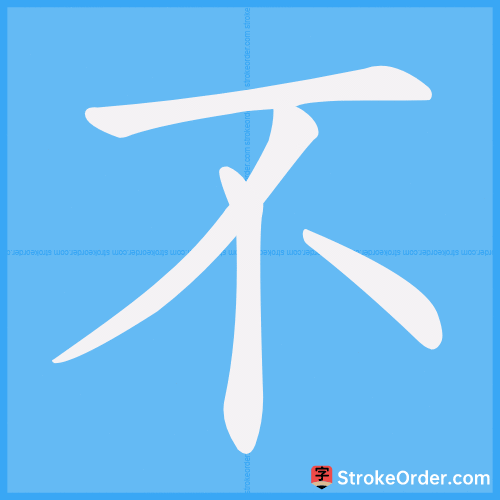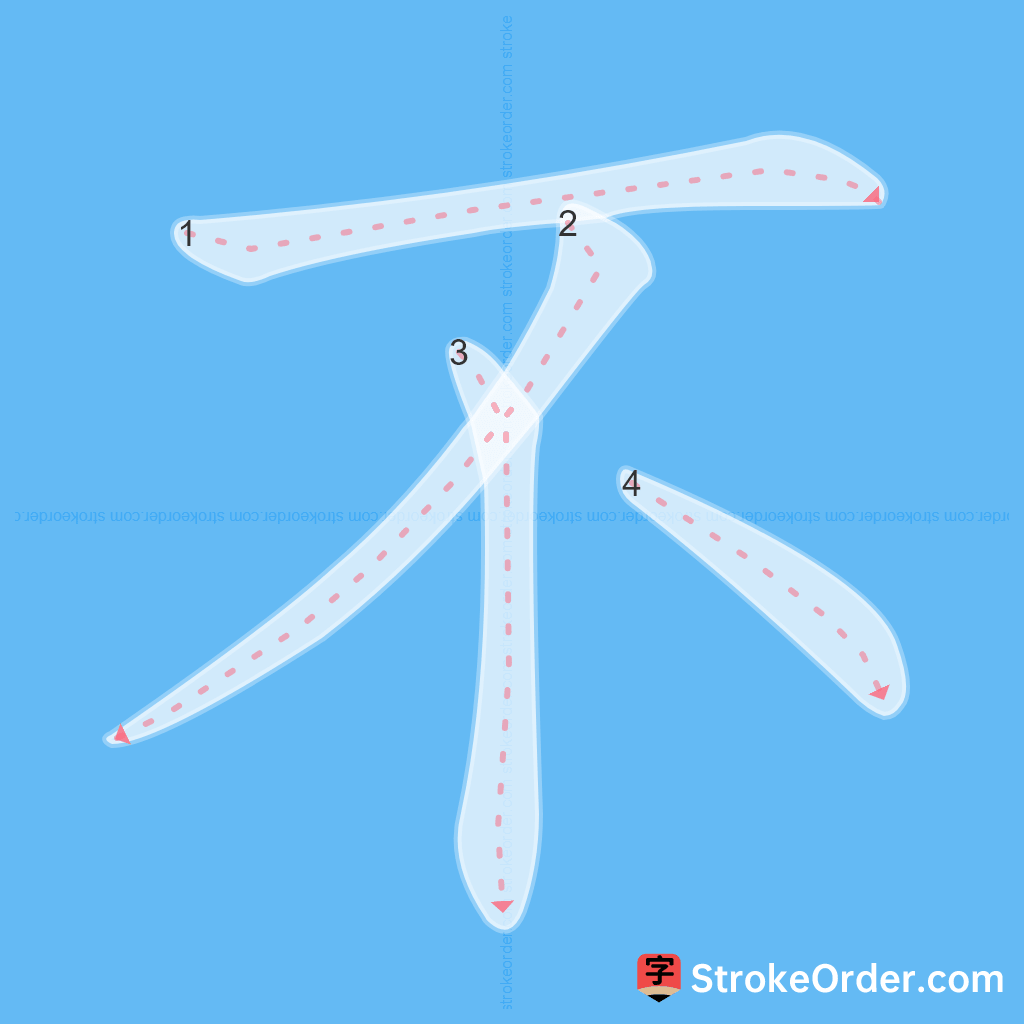不 Stroke Order
Animated Stroke Order of 不

Stroke Order Diagrams for 不

Step-by-Step Handwriting Guide for 不

Learn to Write Chinese Characters with Video Tutorials
Watch the video of writing the Chinese character "不", learn the correct stroke order (笔顺) of the character "不", and master the standard way of writing the character "不".
Free Printable Handwriting Practice with Stroke Order: 不
Printable Writing Practice Worksheet of "不" in Portrait Orientation (Tian Zi Ge)

Printable Writing Practice Worksheet of "不" in Landscape Orientation (Tian Zi Ge)

Information of 不
Pinyin
bù、 fǒu、 fōu、 pī、 pǐ、 fū
Radical
一
Strokes
4 strokes
Usage
★★★★★
Definition
(negative prefix) / not / no
不 [bù]
1. Adverb.
2. Used before verbs, adjectives, and other words to indicate negation or placed before nouns or nominalized morphemes to form adjectives: 不去 (not go), 不多 (not many), 不法 (not lawful), 不料 (unexpected), 不材 (mediocre; often used as a self-deprecating term), 不刊 (without need for modification, indelible), 不学无术 (uneducated and unskilled), 不速之客 (uninvited guest).
3. Used alone as a negative response: 不,我不知道 (No, I don't know).
4. Used at the end of a sentence to indicate a question: 他现在身体好不? (Is he in good health now?)
不 [bù]
1. Adverb.
2. Used before verbs, adjectives, and other words to indicate negation: (not, no).
3. Neither this nor that: (neither…nor).
4. Occurs without the prerequisite conditions for the subsequent actions and states: (without).
5. As a function word, indicating a lack or neglect of a certain action: (without).
6. Used between repeated identical words, often preceded by "什么," indicating indifference or irrelevance: (no matter (what)).
7. Indicates that something is not necessary in terms of logic or feelings: (no need to).
8. Used after a verb to indicate that an expected result or purpose cannot be achieved: (cannot do as expected).
9. Used alone to negate the other person's words or questions: (no).
10. Used at the end of a sentence to form a question: (whether).
不 [bù]
1. Auxiliary.
2. Used to strengthen tone.
3. Used to adjust syllable.
不 [bù]
1. Also means "big" or "great" (通“丕” pī).
2. Note: The character 不 is pronounced as the second tone (阳平) before the fourth tone character (去声), e.g., 不必 (bú bì), 不是 (bú shì).
不 [bù]
Indicates question, uncertainty or indefiniteness, same as "否".
Auxiliary word indicating negation. Same as "否". Example: 《史记》: "上问曰:道军所来,闻鼂错死,吴楚罢不?" (The emperor asked: With the news of Zhao Cao's death, have Wu and Chu ceased fighting?)
Auxiliary word indicating a question or uncertainty, same as "否". Example: 晋·陶渊明: "未知从今去,当复如此不?" (Not sure if going forward will still be the same?)
Noun: A surname, such as 不准 from the Jin dynasty.
Noun: A surname, such as 不准 from the Jin dynasty.
Noun: The peduncle of a flower. Example: 《诗经》: "常棣之华,鄂不韡韡。" (The flowers of the wild plum tree, the peduncle is not withering.)
Noun: The peduncle of a flower. Example: 《诗经》: "常棣之华,鄂不韡韡。" (The flowers of the wild plum tree, the peduncle is not withering.)
to forget and not bear recriminations (idiom); to let bygones be bygones / There is no point in crying over spilt milk.
not to stint / to be generous (with praise etc) / to be prepared to (pay a fee, give of one's time etc)
you are so kind to give me a reply / please favour me you instruction / please don't hesitate to let me know if there is any mistake
lit. not to know whether to laugh or cry (idiom) / both funny and extremely embarrassing / between laughter and tears
lit. a donkey's lips do not match a horse's mouth (idiom) / fig. beside the point / incongruous
Input Method for 不
Pinyin
bu4
Wubi
gii|dhi
Cangjie
mf
Zhengma
gi
Four Corner
10900
Unicode
U+4e0d
Same Pronunciation Characters